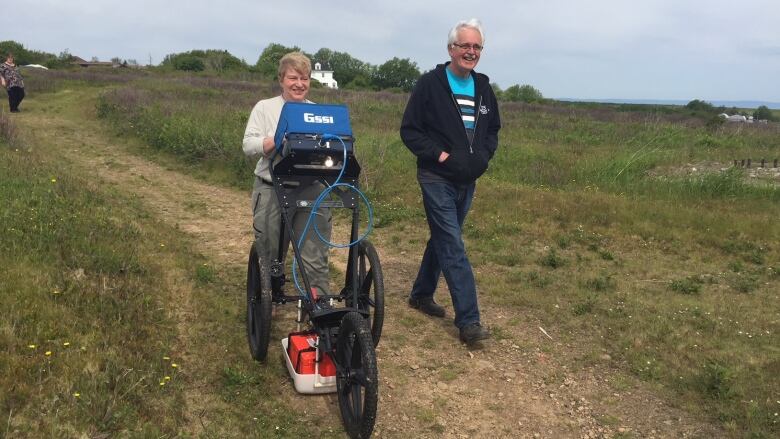Ground-penetrating radar used in effort to locate historic Cape Breton graveyard
'I think it's important to remember where we come from in order to go into the future'

Modern technology is helping unravel a 19th-century mystery in Cape Breton.
The society that is planning a park in Sydney Mines is trying to pinpoint the location of a pioneer graveyard from the early 1800s.
Parks Canada personnel used ground-penetrating radar Thursdayto narrow the search.
Maura McKeough, a cultural resource manager for Parks Canada in Cape Breton, wrestled the radar machine, which looks like a three-wheeled lawnmower, across bumpy terrain on the site of the proposed Atlantic Memorial Park.
She said radar registers variationin wavelengthsthat could signal the presence of graves.
The key, she said, is to look for what isn't there.
'Area of interest'
"Typically, what that would look like on the monitor, you'll see large voids," said McKeough, "and we'll say it's a disturbance.I'm not going to say it's a grave. I'm just going to say there's a disturbance and it's a void, subterranean."
After about an hour of zigzagging across the likely location of the graveyard, McKeough said she'd found an "area of interest."

But to confirm it's a graveyard, she said an archeological dig would be needed. Barring that, she said historical records might confirm the location.
She said there is a chance the voids might not indicate a graveyard at all.
"Maybe it's an old garbage pit," she said. "Maybe it's a privy. That's why archeological and historical research is the next step."
Lots of history
Dale Romeo, the Atlantic Memorial Park Society's historian, said old maps and documents confirm there was a graveyard next to a log church St. Peter's that once stood on the site. It dates to 1824.
He said a picket fence surrounded the graveyard as recently as the Second World War when troops were stationed at the nearby command post.
The society hopes to find more records, and perhaps hear from people in the community who can help confirm the exact site and who is buried there.
"A lot of our pioneer families in Sydney Mines are buried in there," said Romeo,"and I think it's important to remember where we come from in order to go into the future."
Brian Ferguson, the society's planning director, said theaim is to fence off the graveyard once it has been located and incorporate it as part of the park.
"The more history that's here, the more interesting it will be for visitors," he said.
The proposal for Atlantic Memorial Park includes the restoration of the Chapel Point Battery and development of a war memorial and a visitorcentre to recognize Canada's war efforts.












_(720p).jpg)


 OFFICIAL HD MUSIC VIDEO.jpg)
.jpg)



























































































